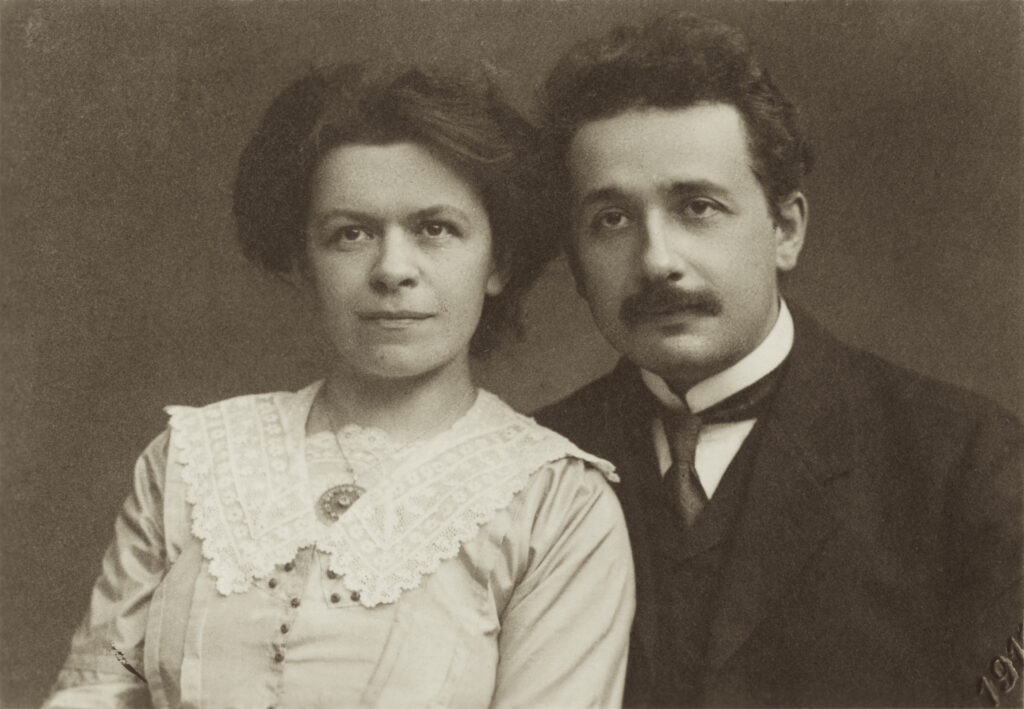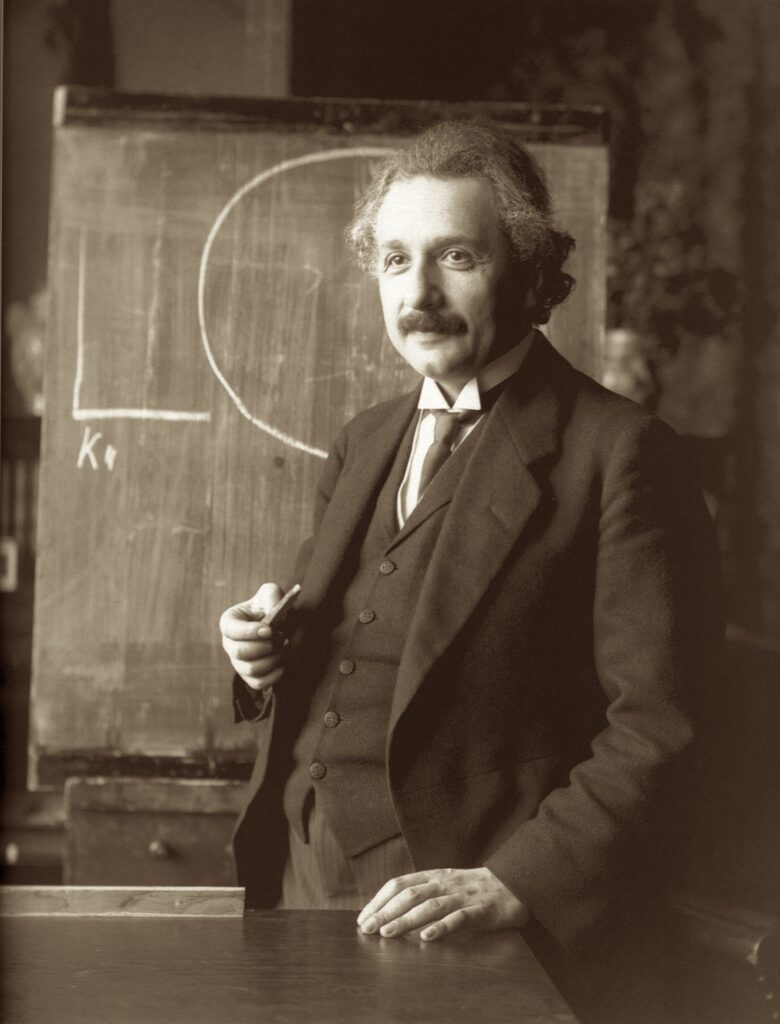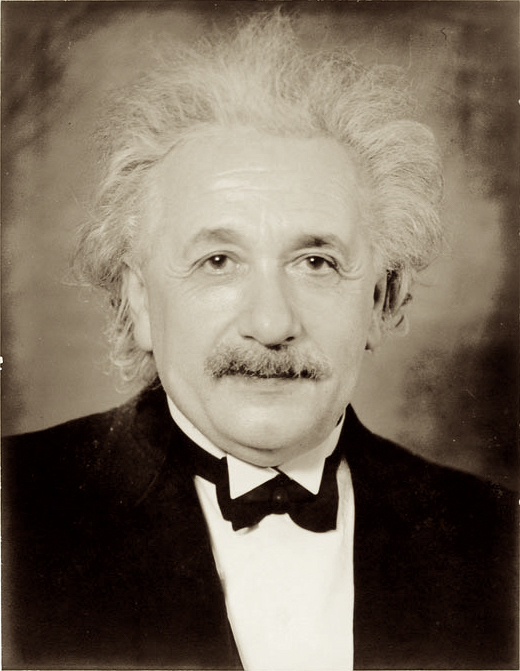About Albert Einstein
He is one of the few real pop stars in science: Albert Einstein, born 1879 in Ulm, Germany. This website is named after him – and that is because Einstein Online evolves around Einstein’s presumably most important contribution to science: the general theory of relativity. But who was the person behind the most successful theory of gravitation, space and time to this day?
Albert Einstein is born in Ulm, Germany, on March 14, 1879. During his childhood, the family moves to Munich – Einstein will stay there until the age of 15. He dislikes the authority-ridden school system and tends to be a pain in the teachers’ necks. Albert leaves his school and Munich behind without a diploma. After staying in Milan with his family, he moves to Switzerland and resumes his school education. In contrast to what rumors say, Einstein excels at school with very good grades in natural sciences and mathematics. In 1896, he obtains his high school diploma. Likely to avoid having to do military service, he gives up German citizenship and registers with no religious affiliation, despite his Jewish roots. Until he is granted Swiss citizenship in 1901, he is stateless.
In 1896, he enrolls at the federal polytechnic school in Zurich for a mathematics and physics teaching program. He meets talented scientists and mathematicians, many of whom become his friends, and falls in love with his classmate Mileva Marić. The two will later get married and have one daughter (*1902) and two sons (*1904, *1910).

At the patent office in Bern
When Einstein graduates in 1900, his applications as a scientific assistant at different universities are without success, wherefore he makes his living as a home teacher. It isn’t until two years after finishing his studies, in summer 1902, that he manages to obtain a position as a technical expert at the patent office in Bern. There, he writes four groundbreaking papers within a few months of the year 1905 – which is why this year has become known as the „Annus Mirabilis“, the miracle year. These four papers of 1905 are a proof of Einstein’s genius:
- „On a Heuristic Viewpoint Concerning the Production and Transformation of Light”, describing the photoelectric effect,
- his dissertation „A New Determination of Molecular Dimensions“, in which he determines the size of sugar molecules and derives a value for the Avogardro constant,
- a work on Brownian motion: „On the Motion of Small Particles Suspended in a Stationary Liquid, as Required by the Molecular Kinetic Theory of Heat“, and ultimately
- the article „On the Electrodynamics of Moving Bodies“ with the addendum „Does the Inertia of a Body Depend Upon Its Energy Content?“ In this article, Einstein deduces the famous equation E = mc².
In the last two papers, Einstein describes the basic concepts of the so-called special theory of relativity. Max Planck, himself one of the fathers of the equally revolutionary theory of quantum mechanics, is one of the first to realize the significance of Einstein’s discovery. When Planck becomes presidium member of the Prussian Academy of Sciences, he will call Einstein to Berlin one decade later.
Einstein, however, only hesitantly leaves his Swiss home. After his habilitation at the University of Bern, he gets a call from Prague, but returns to the confederates only one and a half years later. He assumes a professorship at Zurich University and makes a name for himself with his unconventional lectures. In 1914, he gives in to Planck’s solicitations and moves with his family to Berlin.
Einstein’s time in Berlin
Einstein develops his general theory of relativity between 1908 and 1915, step by step and with the help of his companions like his former fellow student Marcel Grossmann and his former teacher Hermann Minkowski. However, he does not finalize his work until he arrives in Berlin. In the absence of teaching obligations, he devotes himself entirely to his research until it is mature enough for publication. In March 1916, he releases his overview article „The Foundation of the General Theory of Relativity“. This revolutionary theory of space, time and matter is experimentally confirmed in 1919, when Arthur Eddington measures the light deflection by the gravity of the sun during a solar eclipse. Overnight, the entire world knows about Albert Einstein.

Einstein’s private life, in contrast, holds much fewer accomplishments during this time. His marriage is in a deep crisis. His wife Mileva moves back to Switzerland with their children soon after their arrival in Berlin. Einstein, who is already flirting with his cousin Elsa, pushes for a divorce. In 1917, Einstein falls sick and continues to struggle in the following years. Elsa takes care of him. When in 1919, Mileva agrees to divorce him, Einstein marries his cousin. However, in the event that he would win a nobel prize, he promises the money to his first wife.
Therefore, Mileva, too, must have felt quite excited when in November 1922, Albert Einstein is awarded the nobel prize in physics of 1921 – in absence, because the celebrated genius is on his way to Japan for a lecture series. The nobel prize committee honors his achievements in theoretical physics – especially his discovery of the photoelectric effect.
Einstein and quantum theory
Einstein thus receives a nobel prize not only for his efforts regarding relativity, but even more so for his works on the photoelectric effect, which is thought of as a milestone in the development of quantum mechanics. Quantum mechanics of all things – the odd theory that gave Einstein a headache for most of his life! In 1951, he writes to a friend: „The whole fifty years of conscious brooding have not brought me nearer to the answer to the question ‘What are light quanta?“
But the award isn’t an irony of fate, it is actually an almost accurate representation of effort. Einstein once says, he thought a hundred times more about quantum problems than he did about relativity. Despite this, he will never become a huge fan of quantum theory. Until his death he opposes the view that the statistical description that quantum theory requires marks the limit of lawfulness in nature. Instead, he thinks that quantum mechanics is incomplete, and he attacks interpretations that claim otherwise (like Niels Bohr’s Kopenhagen interpretation) with an array of thought experiments, with increasing stubbornness and yet unsuccessfully. Until his passing, he zealously works on a unified field theory, but is unable to find this coveted theory of everything.
Emigration to the USA
In the beginning of the 30s of the 20th century, the atmosphere in Berlin becomes more and more hostile and aggressive. When Adolf Hitler comes to power in 1933, Einstein and Elsa, who come from a Jewish family, emigrate to the US. Einstein resigns from the Prussian Academy of Science on his own account, before the Nazis can push him out. Henceforth, the couple lives in Princeton, New Jersey, where Einstein finds an occupation at the Institute for Advanced Studies. After Elsa’s death in 1936, his sister moves in with him. In 1940, Einstein is granted American citizenship.

Because of his concern that the Nazis would succeed in the construction of a nuclear bomb, and despite his pacifist attitude, Einstein signs a letter to the American president Franklin Roosevelt which recommends to engage in nuclear weapons research and build the bomb first. When nuclear bombs destroy Hiroshima and Nagasaki in 1945, Einstein must witness the consequence of the US’s successful effort. Einstein later refers to his signature as a big mistake. After the war, he promotes the peaceful use of nuclear power and nuclear disarmament. A return to Germany is off the table – the country that murdered millions of Jews is history to him. He dies in Princeton in April 1955 – leaving a scientific heritage that continues to occupy generations of physicists.




